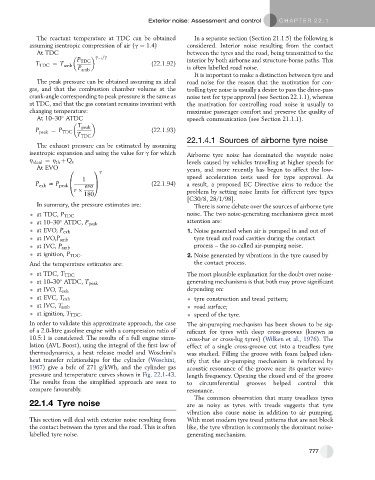Page 766 - Automotive Engineering Powertrain Chassis System and Vehicle Body
P. 766
Exterior noise: Assessment and control C HAPTER 22.1
The reactant temperature at TDC can be obtained In a separate section (Section 21.1.5) the following is
assuming isentropic compression of air (g ¼ 1.4) considered. Interior noise resulting from the contact
At TDC g -1 =g between the tyres and the road, being transmitted to the
P TDC interior by both airborne and structure-borne paths. This
T TDC ¼ T amb (22.1.92)
P amb is often labelled road noise.
It is important to make a distinction between tyre and
The peak pressure can be obtained assuming an ideal road noise for the reason that the motivation for con-
gas, and that the combustion chamber volume at the trolling tyre noise is usually a desire to pass the drive-pass
crank-angle corresponding to peak pressure is the same as noise test for type approval (see Section 22.1.1), whereas
at TDC, and that the gas constant remains invariant with the motivation for controlling road noise is usually to
changing temperature: maximise passenger comfort and preserve the quality of
At 10–30 ATDC speech communication (see Section 21.1.1).
T peak
P peak ¼ P TDC (22.1.93)
T TDC
22.1.4.1 Sources of airborne tyre noise
The exhaust pressure can be estimated by assuming
isentropic expansion and using the value for g for which Airborne tyre noise has dominated the wayside noise
h ideal ¼ h þQ c levels caused by vehicles travelling at higher speeds for
th
At EVO 0 1 g years, and more recently has begun to affect the low-
B 1 C speed acceleration tests used for type approval. As
P exh z P peak @ evo A (22.1.94) a result, a proposed EC Directive aims to reduce the
r problem by setting noise limits for different tyre types
180
[C30/8, 28/1/98].
In summary, the pressure estimates are: There is some debate over the sources of airborne tyre
noise. The two noise-generating mechanisms given most
at TDC, P TDC
attention are:
at 10–30 ATDC, P peak
at EVO, P exh 1. Noise generated when air is pumped in and out of
at IVO,P amb tyre tread and road cavities during the contact
process – the so-called air-pumping noise.
at IVC, P amb
at ignition, P TDC . 2. Noise generated by vibrations in the tyre caused by
And the temperature estimates are: the contact process.
at TDC, T TDC The most plausible explanation for the doubt over noise-
at 10–30 ATDC, T peak generating mechanisms is that both may prove significant
depending on:
at IVO, T exh
at EVC, T exh tyre construction and tread pattern;
at IVC, T amb road surface;
at ignition, T TDC . speed of the tyre.
In order to validate this approximate approach, the case The air-pumping mechanism has been shown to be sig-
of a 2.0-litre gasoline engine with a compression ratio of nificant for tyres with deep cross-grooves (known as
10.5:1 is considered. The results of a full engine simu- cross-bar or cross-lug tyres) (Wilken et al., 1976). The
lation (AVL Boost), using the integral of the first law of effect of a single cross-groove cut into a treadless tyre
thermodynamics, a heat release model and Woschini’s was studied. Filling the groove with foam helped iden-
heat transfer relationships for the cylinder (Woschini, tify that the air-pumping mechanism is reinforced by
1967) give a bsfc of 271 g/kWh, and the cylinder gas acoustic resonance of the groove near its quarter wave-
pressure and temperature curves shown in Fig. 22.1-43. length frequency. Opening the closed end of the groove
The results from the simplified approach are seen to to circumferential grooves helped control this
compare favourably. resonance.
The common observation that many treadless tyres
22.1.4 Tyre noise are as noisy as tyres with treads suggests that tyre
vibration also cause noise in addition to air pumping.
This section will deal with exterior noise resulting from With most modern tyre tread patterns that are not block
the contact between the tyres and the road. This is often like, the tyre vibration is commonly the dominant noise-
labelled tyre noise. generating mechanism.
777

